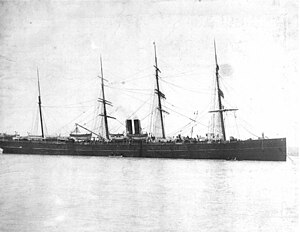 City of Peking anchored in San Francisco Bay, May 1898.
| |
| History | |
|---|---|
| Name | City of Peking |
| Namesake | Beijing, China |
| Owner | |
| Operator | |
| Port of registry | New York[1] |
| Route | San Francisco – Yokohama – Hong Kong |
| Builder | John Roach & Sons, Delaware River Iron Ship Building and Engine Works |
| Yard number | 130 |
| Launched | March 19, 1874 |
| Maiden voyage | February 1875 |
| Fate | Scrapped 1920 |
| General characteristics | |
| Type | Passenger & cargo |
| Tonnage | 5,079 GRT |
| Length | 423 ft (129 m) |
| Beam | 47 ft 4 in (14.4 m) |
| Draft | 38 ft 6 in (11.7 m) |
| Installed power | 5,000 horsepower[clarification needed] |
| Propulsion | compound steam engine,[2] screw propeller, auxiliary sails |
| Sail plan | 4-masted bark |
| Speed | 14.5 knots (26.9 km/h) |
| Capacity | Passengers: 120 1st class, 250 2nd class, 1,000 steerage class |
SS City of Peking was an iron-hulled steamship built in 1874 by Delaware River Iron Ship Building and Engine Works, Chester, Pennsylvania for the Pacific Mail Steamship Company. City of Peking and her sister ship City of Tokio were at the time of construction the largest vessels ever built in the United States, and the second largest in the world behind the British leviathan Great Eastern.[3]
Like Great Eastern, construction of the two Pacific Mail ships was to be plagued with financial difficulties, which threatened to bankrupt the shipbuilder. Unlike Great Eastern, however, which was a commercial failure, City of Peking would go on to have a long and successful commercial career.
In addition to her cargoes, City of Peking brought many Chinese and Japanese immigrants to the United States, and later served as a troopship in the Spanish–American War.
- ^ Ringwalt, John Luther (1888). Development of Transportation Systems in the United States: Comprising a Comprehensive Description of the Leading Features of Advancement, from the Colonial Era to the Present Time, in Water Channels, Roads, Turnpikes, Canals, Railways, Vessels, Vehicles, Cars and Locomotives. author, Railway World Office. pp. 290. Retrieved 8 September 2013.
Columbia 1880.
{{cite book}}:|work=ignored (help) - ^ Cite error: The named reference
bolleswas invoked but never defined (see the help page). - ^ Swann p. 81.